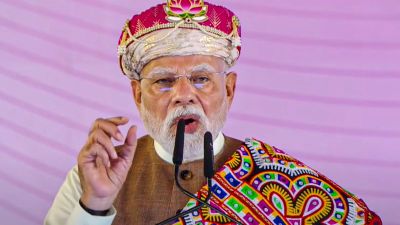Ketan Parekh 2.0: The return of the kingpin of two stock scams, nearly a quarter of a century apart
On January 2, the Securities and Exchange Board of India (SEBI) debarred Dalal Street scam-tainted trader Ketan Parekh and others for alleged front-running of trades of a US-based foreign portfolio investor (FPI).
 Ketan Parekh indulged in manipulative trades that led to the stock markets crash in 2001. (Express File Photo)
Ketan Parekh indulged in manipulative trades that led to the stock markets crash in 2001. (Express File Photo)After almost 25 years, Ketan Parekh, the mastermind behind the 2000-01 stock market scam, has resurfaced, now entangled in yet another manipulation scandal that has been flagged by the Indian stock market regulator. The Securities and Exchange Board of India (SEBI) has censured Parekh’s latest scheme, exposing his involvement in a front-running case that has sent shockwaves through the financial markets.
Parekh in 2000
Parekh, described as the “pied piper” of the Indian stock market in the late 90s and early 2000s for his ability to lure investors in a certain direction, had built a dubious reputation for his devious tactics and ability to manipulate stock prices. His previous scam, which unfolded in 2000-01, had badly dented investor confidence after a large number of them suffered heavy losses and the BSE faced extreme fluctuations. This time around, Sebi has blown the lid off Parekh’s alleged front-running activities, sparking concerns about the integrity of the market and the effectiveness of regulatory oversight.
A chartered accountant by profession, Parekh started his career in the late 1980s and became hyper active in the stock markets between 1999-2001 by rigging up the shares of information, communication and entertainment (ICE) companies using the circular trading, Gujarat-based Madhavpura Mercantile Co-operative Bank and the Kolkata stock exchange where rules were lax. Parekh, who was mentored by Harshad Mehta, the kingpin of the 1991 stock market scam, led the bull rally in 1999-2000 which coincided with the global dotcom boom and burst. Other investors and traders blindly followed the Parekh moves in rigging up ten ICE companies which were then known as K-10 stocks. Even promoters of some companies funded Parekh to boost their shares.
Parekh’s alleged modus operandi in the 2001 scheme was to rig share prices of firms in collusion with promoters through circular trading. Circular trading is a fraudulent trading scheme where sell orders are entered by a broker who knows that offsetting buy orders, either have been or will be entered. As a result, these trades don’t represent any change in the beneficial ownership of the security.
He kept a low profile and refused to come into the media limelight during his heydays 25 years ago.
The scam was unravelled in the wake of a payment crisis in Kolkata exchange and his involvement in fund transfer from Madhavpura Co-op Bank. Stock market indices tanked and collapse was further catalysed by the bursting of global dotcom bubble. Various government agencies started investigations and Sebi banned him from the market for 14 years in 2003.
A Special CBI court also convicted him for two years in 2014. The scam eventually led to the collapse of UTI and tightening of norms by Sebi.
Parekh in 2024
After an investigation lasting two and a half years, Sebi found that Ketan Parekh and 21 others (Sebi Noticees) were allegedly involved in front-running of trades of a US-based foreign portfolio investor (FPI).
Front running is the illegal practice of purchasing a stock based on advanced non-public information regarding an expected large transaction that will affect the price of the stock.
Considering the pattern of trades in common scrips by some of “Noticees” with various funds of an overseas entity which are engaged in the business of the FPI (Sebi did not disclose its name and referred it as a “Big Client”), further examination was conducted in order to ascertain whether acts of the above Noticees were in violation of provisions of the Sebi regulations.
Based on the evidence collected during the search and seizure operation, it was prima facie suspected that, in addition to traditional front running, the frontrunners (FRs) used “complex trading strategies” to take advantage of the prior knowledge of the impending trades of “the Big Client”. After obtaining due permission of the competent court, a search and seizure operation was carried out over a period of three days starting on June 22, 2023 at the premises of 17 entities wherein various documentary and electronic evidences were gathered and statements of various Noticees were recorded on oath.
The main character in the front-running case is a certain Rohit Salgaocar (who is also Noticee No. 1), a Singapore resident who is the director and authorised signatory of a company called Strait Crossing Pte Limited (SCPL), who entered into a referral agreement with Motilal Oswal Financial Services Ltd and Nuvama Wealth Management to refer trades of the Big Client to them. The traders of the Big Client used to consult Salgaocar prior to placing orders in Indian markets and thus Salgaocar allegedly had access to the non-public information (NPI) with respect to substantial impending transaction in various scrips.
Parekh, allegedly, obtained NPI from Salgaocar and orchestrated the whole scheme to communicate trading instructions based on NPI to other Noticees. In the past, Parekh and his group entities were prohibited from dealing in the securities and debarred from associating with the securities market for a period of 14 years vide Sebi order dated December 12, 2003.
Sebi said six frontrunners allegedly traded on the basis of instructions received, directly or indirectly, from Parekh which were allegedly based on NPI with respect to substantial impending transaction of the Big Client in various scrips. The Big Client is a US-based fund house which has various funds registered as FPIs with Sebi. These FPIs invest in the Indian securities markets through various registered trading members.
Facts unearthed during the search and seizure operations of the Sebi, revealed that 22 Noticees adopted a modus operandi. Prior to execution of suspicious trades, FRs were receiving trade instructions through WhatsApp chats or calls from a person whose contact numbers was saved in the devices as Jack/Jack New/Jack Latest New/Boss, etc. After the analysis of these contact numbers, it was found that these numbers belonged to Parekh who was receiving NPI from Salgaocar. After receiving specific and timely instructions, directly or indirectly, from Parekh, the frontrunners used to execute orders and made unjust profits.
Sebi investigation further revealed that the Big Client used to place orders containing the scrip name, buy or sell quantity and buy or sell price through their order messaging system called FIX. For orders routed through Motilal and Nuvama, traders used to execute such orders. However, the instructions regarding execution of these orders such as details of the scrip, time quantity and price of the order, were dictated by Salgaocar. It was found that SCPL, the company owned by Salgaocar, had entered into a referral agreement with Nuvama and Motilal for revenue sharing of the brokerage earned on trades of the Big Client referred by SCPL.
The regulator’s analysis of orders placed by the Big Client and FRs revealed the recurrent matching of the scrip, price, quantity and timing of trades between the Big Client and FRs which would not have been possible unless FRs were in possession of NPI or NPI-based trading instructions relating to impending orders of the Big Client in various scrips.
The matter was further investigated by the Sebi and it was observed that the NPI relating to impending orders of the Big Client was being passed from Salgaocar to Parekh, who in turn used to communicate trading instructions based on such NPI, directly or indirectly, to the six FRs for execution in order to gain undue profits.
As the investigation unfolds, one thing is clear: Parekh’s actions have once again brought the spotlight on the need for stringent regulations and proactive monitoring to prevent market manipulation. The question is: how did Parekh manage to evade detection and orchestrate another elaborate scam? The answer lies in his ability to exploit loopholes and manipulate the system, often using complex tactics like front running, circular trading and pump-and-dump schemes.
As the authorities delve deeper into the case, it remains to be seen what consequences Parekh will face and what measures will be taken to prevent such scams from recurring. One thing is certain, however: the Indian stock market will be watching this case closely, eager to see justice is served and faith restored in the system.
NOTICEES IN FRONT-RUNNING CASE
Information Carriers
- Rohit Salgaocar
- Ketan Parekh
Front Runners (FRs)
- GRD Securities Ltd
- Salasar Stock Broking Ltd
- Anirudh Damani
- Ashok Kumar Damani
- Basukinath Properties
- APR Properties Private Ltd
Facilitators
- Sanjay Taparia
- Ashok Kumar Poddar
- Sumit Sonthalia
Directors
- Pramod Kumar Drolia
- Bimal Kumar Drolia
- Priya Saraf (also Facilitator)
- Anita Drolia
- Kiran Kumar Sonthalia
- Shyam Saraogi (also Facilitator)
- Pradeep Saraogi (also Facilitator)
- Rachit Poddar (also Facilitator)
- Manoj Kumar Agarwal
- Mahendra Kumar Agarwal
- Renu Agarwal
Source: SEBI
Photos


- 01
- 02
- 03
- 04
- 05





























